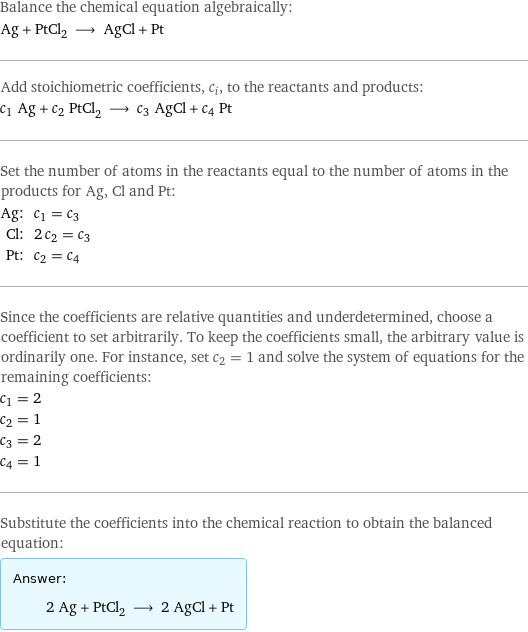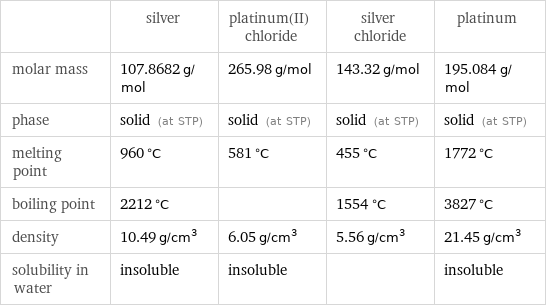Input interpretation

Ag silver + PtCl_2 platinum(II) chloride ⟶ AgCl silver chloride + Pt platinum
Balanced equation

Balance the chemical equation algebraically: Ag + PtCl_2 ⟶ AgCl + Pt Add stoichiometric coefficients, c_i, to the reactants and products: c_1 Ag + c_2 PtCl_2 ⟶ c_3 AgCl + c_4 Pt Set the number of atoms in the reactants equal to the number of atoms in the products for Ag, Cl and Pt: Ag: | c_1 = c_3 Cl: | 2 c_2 = c_3 Pt: | c_2 = c_4 Since the coefficients are relative quantities and underdetermined, choose a coefficient to set arbitrarily. To keep the coefficients small, the arbitrary value is ordinarily one. For instance, set c_2 = 1 and solve the system of equations for the remaining coefficients: c_1 = 2 c_2 = 1 c_3 = 2 c_4 = 1 Substitute the coefficients into the chemical reaction to obtain the balanced equation: Answer: | | 2 Ag + PtCl_2 ⟶ 2 AgCl + Pt
Structures

+ ⟶ +
Names

silver + platinum(II) chloride ⟶ silver chloride + platinum
Reaction thermodynamics
Enthalpy

| silver | platinum(II) chloride | silver chloride | platinum molecular enthalpy | 0 kJ/mol | -123.4 kJ/mol | -127 kJ/mol | 0 kJ/mol total enthalpy | 0 kJ/mol | -123.4 kJ/mol | -254 kJ/mol | 0 kJ/mol | H_initial = -123.4 kJ/mol | | H_final = -254 kJ/mol | ΔH_rxn^0 | -254 kJ/mol - -123.4 kJ/mol = -130.6 kJ/mol (exothermic) | | |
Equilibrium constant
![Construct the equilibrium constant, K, expression for: Ag + PtCl_2 ⟶ AgCl + Pt Plan: • Balance the chemical equation. • Determine the stoichiometric numbers. • Assemble the activity expression for each chemical species. • Use the activity expressions to build the equilibrium constant expression. Write the balanced chemical equation: 2 Ag + PtCl_2 ⟶ 2 AgCl + Pt Assign stoichiometric numbers, ν_i, using the stoichiometric coefficients, c_i, from the balanced chemical equation in the following manner: ν_i = -c_i for reactants and ν_i = c_i for products: chemical species | c_i | ν_i Ag | 2 | -2 PtCl_2 | 1 | -1 AgCl | 2 | 2 Pt | 1 | 1 Assemble the activity expressions accounting for the state of matter and ν_i: chemical species | c_i | ν_i | activity expression Ag | 2 | -2 | ([Ag])^(-2) PtCl_2 | 1 | -1 | ([PtCl2])^(-1) AgCl | 2 | 2 | ([AgCl])^2 Pt | 1 | 1 | [Pt] The equilibrium constant symbol in the concentration basis is: K_c Mulitply the activity expressions to arrive at the K_c expression: Answer: | | K_c = ([Ag])^(-2) ([PtCl2])^(-1) ([AgCl])^2 [Pt] = (([AgCl])^2 [Pt])/(([Ag])^2 [PtCl2])](../image_source/560187ee9d78ae3ff046db0e1f14c8eb.png)
Construct the equilibrium constant, K, expression for: Ag + PtCl_2 ⟶ AgCl + Pt Plan: • Balance the chemical equation. • Determine the stoichiometric numbers. • Assemble the activity expression for each chemical species. • Use the activity expressions to build the equilibrium constant expression. Write the balanced chemical equation: 2 Ag + PtCl_2 ⟶ 2 AgCl + Pt Assign stoichiometric numbers, ν_i, using the stoichiometric coefficients, c_i, from the balanced chemical equation in the following manner: ν_i = -c_i for reactants and ν_i = c_i for products: chemical species | c_i | ν_i Ag | 2 | -2 PtCl_2 | 1 | -1 AgCl | 2 | 2 Pt | 1 | 1 Assemble the activity expressions accounting for the state of matter and ν_i: chemical species | c_i | ν_i | activity expression Ag | 2 | -2 | ([Ag])^(-2) PtCl_2 | 1 | -1 | ([PtCl2])^(-1) AgCl | 2 | 2 | ([AgCl])^2 Pt | 1 | 1 | [Pt] The equilibrium constant symbol in the concentration basis is: K_c Mulitply the activity expressions to arrive at the K_c expression: Answer: | | K_c = ([Ag])^(-2) ([PtCl2])^(-1) ([AgCl])^2 [Pt] = (([AgCl])^2 [Pt])/(([Ag])^2 [PtCl2])
Rate of reaction
![Construct the rate of reaction expression for: Ag + PtCl_2 ⟶ AgCl + Pt Plan: • Balance the chemical equation. • Determine the stoichiometric numbers. • Assemble the rate term for each chemical species. • Write the rate of reaction expression. Write the balanced chemical equation: 2 Ag + PtCl_2 ⟶ 2 AgCl + Pt Assign stoichiometric numbers, ν_i, using the stoichiometric coefficients, c_i, from the balanced chemical equation in the following manner: ν_i = -c_i for reactants and ν_i = c_i for products: chemical species | c_i | ν_i Ag | 2 | -2 PtCl_2 | 1 | -1 AgCl | 2 | 2 Pt | 1 | 1 The rate term for each chemical species, B_i, is 1/ν_i(Δ[B_i])/(Δt) where [B_i] is the amount concentration and t is time: chemical species | c_i | ν_i | rate term Ag | 2 | -2 | -1/2 (Δ[Ag])/(Δt) PtCl_2 | 1 | -1 | -(Δ[PtCl2])/(Δt) AgCl | 2 | 2 | 1/2 (Δ[AgCl])/(Δt) Pt | 1 | 1 | (Δ[Pt])/(Δt) (for infinitesimal rate of change, replace Δ with d) Set the rate terms equal to each other to arrive at the rate expression: Answer: | | rate = -1/2 (Δ[Ag])/(Δt) = -(Δ[PtCl2])/(Δt) = 1/2 (Δ[AgCl])/(Δt) = (Δ[Pt])/(Δt) (assuming constant volume and no accumulation of intermediates or side products)](../image_source/15cba0fcc93d30f4d14f69ebe3b66244.png)
Construct the rate of reaction expression for: Ag + PtCl_2 ⟶ AgCl + Pt Plan: • Balance the chemical equation. • Determine the stoichiometric numbers. • Assemble the rate term for each chemical species. • Write the rate of reaction expression. Write the balanced chemical equation: 2 Ag + PtCl_2 ⟶ 2 AgCl + Pt Assign stoichiometric numbers, ν_i, using the stoichiometric coefficients, c_i, from the balanced chemical equation in the following manner: ν_i = -c_i for reactants and ν_i = c_i for products: chemical species | c_i | ν_i Ag | 2 | -2 PtCl_2 | 1 | -1 AgCl | 2 | 2 Pt | 1 | 1 The rate term for each chemical species, B_i, is 1/ν_i(Δ[B_i])/(Δt) where [B_i] is the amount concentration and t is time: chemical species | c_i | ν_i | rate term Ag | 2 | -2 | -1/2 (Δ[Ag])/(Δt) PtCl_2 | 1 | -1 | -(Δ[PtCl2])/(Δt) AgCl | 2 | 2 | 1/2 (Δ[AgCl])/(Δt) Pt | 1 | 1 | (Δ[Pt])/(Δt) (for infinitesimal rate of change, replace Δ with d) Set the rate terms equal to each other to arrive at the rate expression: Answer: | | rate = -1/2 (Δ[Ag])/(Δt) = -(Δ[PtCl2])/(Δt) = 1/2 (Δ[AgCl])/(Δt) = (Δ[Pt])/(Δt) (assuming constant volume and no accumulation of intermediates or side products)
Chemical names and formulas

| silver | platinum(II) chloride | silver chloride | platinum formula | Ag | PtCl_2 | AgCl | Pt Hill formula | Ag | Cl_2Pt | AgCl | Pt name | silver | platinum(II) chloride | silver chloride | platinum IUPAC name | silver | dichloroplatinum | chlorosilver | platinum
Substance properties

| silver | platinum(II) chloride | silver chloride | platinum molar mass | 107.8682 g/mol | 265.98 g/mol | 143.32 g/mol | 195.084 g/mol phase | solid (at STP) | solid (at STP) | solid (at STP) | solid (at STP) melting point | 960 °C | 581 °C | 455 °C | 1772 °C boiling point | 2212 °C | | 1554 °C | 3827 °C density | 10.49 g/cm^3 | 6.05 g/cm^3 | 5.56 g/cm^3 | 21.45 g/cm^3 solubility in water | insoluble | insoluble | | insoluble
Units
